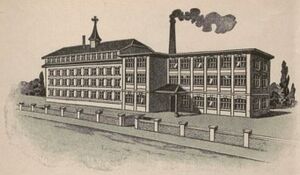Reconvilier Watch Company: Difference between revisions
No edit summary |
No edit summary |
||
| Line 8: | Line 8: | ||
The ebauche factory was established three years later by Dr. Tièche, who sought to challenge the [[Fabrique d'Horlogerie de Fontainemelon]] and build industry in the village. | The ebauche factory was established three years later by Dr. Tièche, who sought to challenge the [[Fabrique d'Horlogerie de Fontainemelon]] and build industry in the village. | ||
Dr. Tièche also founded the first brass foundry in Switzerland, [[Bueche, Boillat et Cie]], with Guillaume-Olivier Bueche, his son-in-law Edouard Boillat, and Ernest Kraft. The two firms worked closely together for the rest of the 19th century. | In [[1855]] Dr. Tièche also founded the first brass foundry in Switzerland, [[Bueche, Boillat et Cie]], with Guillaume-Olivier Bueche, his son-in-law Edouard Boillat, and Ernest Kraft. The two firms worked closely together for the rest of the 19th century. | ||
==Kuhn et Tièche== | ==Kuhn et Tièche== | ||
Revision as of 21:19, 24 June 2024

The Reconvilier Watch Company was founded in 1853 by Dr. Tièche in Reconvilier.
Tièche Ebauches
On February 13, 1850, the executive council of the canton of Berne granted authorization for the construction of a weir and lock across the river Birse in Reconvilier for the production of hydraulic power. This was done at the request of Dr. Emmanuel-Aimé Tièche (1810-1867), who sought to promote the industrial development of Reconvilier.
The ebauche factory was established three years later by Dr. Tièche, who sought to challenge the Fabrique d'Horlogerie de Fontainemelon and build industry in the village.
In 1855 Dr. Tièche also founded the first brass foundry in Switzerland, Bueche, Boillat et Cie, with Guillaume-Olivier Bueche, his son-in-law Edouard Boillat, and Ernest Kraft. The two firms worked closely together for the rest of the 19th century.
Kuhn et Tièche
On January 1, 1870, Charles Kuhn (1831-1888) and Emile Tièche took over the Tièche ebauche factory. The two were brothers-in-law, having married daughters of Louis Barbier of Bienne. Kuhn had previously founded an iron business in Bienne in 1861 and would go on to become a municipal councilor, mayor of Bienne, and representative in the national council.
The factory was initially called Tièche, Kuhn & Cie. but was simply called Kuhn et Tièche by 1873. It was listed as a "Fabrique d'ébauches, finissages et remontoirs et tuilerie mécanique" ("factory of ebauches, finishing and reassembly, and mechanical tools").
They expanded production to include the manufacturing of ebauches in addition to cases and complete watches. In 1883 the company received a diploma at the Swiss National Exhibition in Zurich. According to an 1884 article in Journal Suisse d'Horlogerie, the firm exhibited "pendant and key components of a wide variety of calibres and winding systems, with special arrangement for calendar. Their showcase also contained gold watch boxes from their workshop, and an assortment of watches with various decorations, gold, silver and metal. Kuhn & Tièche also works according to the principle of interchangeability of movement components, with ebauches that are completely finished by machine. By a cutting process, the angles of the bridges and thin plates come out as well finished as by hand." In 1885 the company was awarded a bronze medal at the Universal Exhibition in Antwerp for the excellence of its products.
The headquarters of the company was moved to Bienne in 1883 though the factory in Reconvilier remained in operation. Initially located at Pasquart 53, it was moved to Rue Haute 35 in 1886, Fontaines 4 in 1893, and Rue Haute 5 by 1900. This was a residential and office building in the old town of Bienne.
Tièche, Kuhn & Cie
The name Tièche, Kuhn & Cie reappeared as the name of a private bank in Bienne in 1895. This was located at Rue Haute 5 alongside the headquarters of Kuhn et Tièche through 1903.
Tièche, Kuhn & Cie. began as Barbier-Moser & Cie. in 1859, founded by Louis Barbier in Biel. After Barbier's death in 1876, the bank passed to his sons-in-law and was renamed Tièche, Kuhn & Cie. It operated until November 1901 when it closed, with Volksbank Biel assuming its assets. The bank's closure marked a shift in Biel's banking landscape, influenced by industrial crises and competition.
Société Horlogère Reconvilier
On September 5, 1902, a public limited company took over the factory. This Société Anonyme brought additional funding to expand manufacturing. This is the date referenced throughout the 20th century as the founding date of the firm, despite the fact that it was already 50 years old at the time. The company, called Société Horlogère Reconvilier (Reconvilier Watch Co) was founded by Ferdinand Grillet, Aloys du Mont, Ernest Krayenbühl, and Georges Ruedin, who was made the director. Grillet would remain chairman of the board through the 1920s, but du Mont died in 1923 and was replaced by his grandson, Roger Krayenbühl.
Specializing at first only on higher-quality Roskopf watches, the factory soon began to manufacture anchor pocket watches and wristwatches. The Roskopf System watches produced there included an elegant model only 22 twelfths high, and Reconvilier also manufactured the exact watch envisioned by Louis Roskopf.

In the 1930s the company added production of 8-day clocks and other specialties such as automatic switches for radios, illuminated advertisements, and more. The factory was lead up to this point by Georges Ruedin, who died in 1935. By this point it employed nearly two hundred workers, of which more than a third had been with the firm for more than 25 years.
In 1942 the Reconvilier Watch Co. celebrated its 50th anniversary. Contemporary advertisements show a range of watches in various popular styles with the words "Qualite" and "Precision". The company used the brands Reconvilier, Hercules, and Louis Roskopf on various products.
André Ruedin (1902-1947) administered the company during this time but died suddenly in 1947 of a heart attack. He had worked at the firm since February 1926 and took over following the death of his father, Georges Ruedin in 1935.